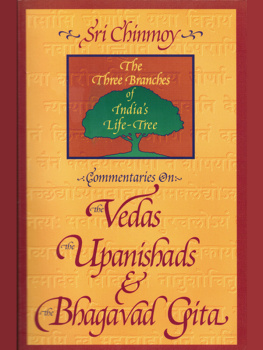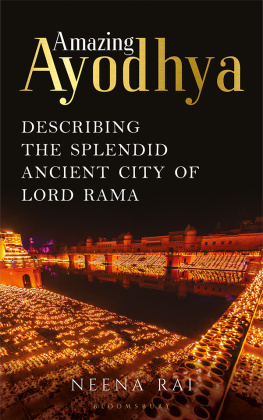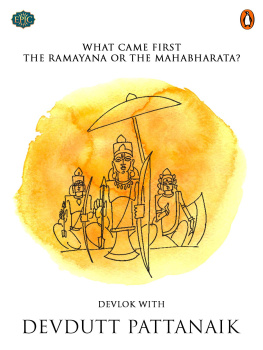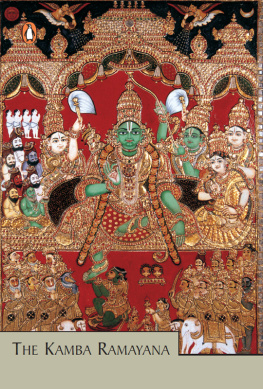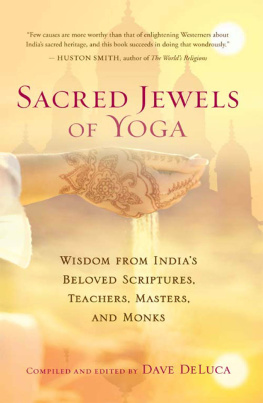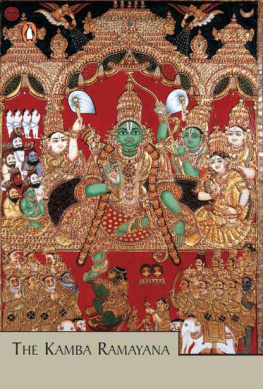RAMAYANA
Indias Immortal Tale of Adventure,Love and Wisdom
Retold byKrishnaDharma
Copyright 1998, 2014 by Krishna Dharma
a.k.a. Kenneth Anderson
The right of Krishna Dharma to be identified asauthor of this Work has been asserted by him in accordance with theCopyright, Designs and Patent Act 1988.
Smashwords Edition
All rights reserved. No part of this publication maybe reproduced, stored in a retrieval system or transmitted in anyform or by any means, electronic, mechanical, photocopying,recording or otherwise, without prior permission of KrishnaDharma.
INTRODUCTION
The Ramayana is a part of the Vedas, the ancient Sanskritscriptures of India, and it is famous as the Adi Kavya, or theoriginal poem. Its origins are lost in distant antiquity, althoughfollowers of the Vedic tradition say it was first composed around878,000 BC. Of course, many modern scholars and scientists willundoubtedly take issue with that claim. It matters little thoughwhen it was written as The Ramayana remains one of the most movingand beautiful stories of all time. It tells the history of Rama, aking who appeared in the solar dynasty, or the line descending fromthe sun-god Vivasvan. He and his wife Sita are said by the Vedas tobe manifestations of Vishnu and Lakshmi, who are accepted as theSupreme Person and His eternal consort. Rama is supposed to be theseventh of the ten avatars or incarnationsof Vishnu who appear in the current cycle of ages.
The book can thus be read on differentlevels. On one level it is simply a wonderful story. For lovers oftales like Lord of the Rings it is an account of fantastichappenings in a world of magic and mysticism. A world where humanslived alongside other more powerful beings and where human societyitself possessed knowledge of divine forces now unknown.
For those fascinated by different cultures,The Ramayana graphically depicts the so-called Vedic age, a timewhen great warrior kings ruled the world, guided by spirituallyaware mystics and saints. It was an age when men lived in theunderstanding that they were eternal souls, passing from life tolife towards a state of final emancipation. Thus the pursuit ofvirtue and truth was considered paramount and human life was seenas an opportunity to attain spiritual liberation, or freedom fromthe cycle of birth and death.
But for those who accept the divinity ofRama, The Ramayana becomes a different affair. If Rama is acceptedas God then the question is, why does he appear? What is he doingas he moves about the earth, seeming to act exactly like anordinary man?
Such questions are answered in another of theVedic literatures, the Bhagavad-gita. In there it is stated thatGod appears in this world for different reasons. He comes toestablish religion and to destroy demonic elements in society whenthey become too powerful. But he also appears in order toreciprocate the love of his devotees. It is this last fact which ismost significant and which is said to be the primary reason for theLords appearance. The Bhagavad-gita explains that the Lord has nomaterial purpose to fulfil when he appears. He is not acting in thesame way as ordinary men who are interested in material gains suchas profit, fame and adoration. Nor does the Lord have any politicalpurpose. He is simply acting out of love.
If The Ramayana is studied with this inmind it becomes an immensely profound and deeply moving literature.The various interactions between Rama and the other characters areseen in a different light; a light of divine loving sentimentswhich touch the very soul of the reader.
I shall leave you to judge for yourself.However you view The Ramayana I am confident you will find itenjoyable and uplifting. I have read it at least a dozen times andam still finding very great pleasure in reading it again and again.I hope you will also experience the same joy from this book.
Krishna Dharma
THE RAMAYANA
PROLOGUE
Coursingthrough the sky in his celestial chariot, Ravana appeared like ablazing comet. His dark body shone with a brilliant aura. From histen heads his reddish eyes darted about, scouring the mountainsbelow. His twenty powerful arms hanging from his huge frame lookedlike five-hooded serpents. Seated on a throne of gems he directedhis golden chariot by thought alone and it moved swiftly over theHimalayan range.
The demon was out on his conquests. Allaround him flew thousands of Rakshasas, clutching swords, barbedspears, spiked maces and iron bludgeons, all of those weaponssmeared with blood. Some Rakshasas had the heads of tigers, some ofdonkeys and some of fierce fiends. Others appeared in their naturalforms: large blackish bodies, fearful faces with tall pointed earsand rows of sharp fangs, with a mass of red hair on their heads.They wore iron breastplates studded with gems and were adorned withbright gold earrings and other shining ornaments. SurroundingRavana they looked like dark clouds with lightning covering thesun.
Ravana wished to defeat in battle even thegods themselves. Wanting to establish his supreme power in theuniverse, he had gone to the higher planets and conquered hosts ofGandharvas and Yakshas, powerful celestial fighters. Now he wasreturning from his victorious fight with Kuvera, his own brotherand the treasurer of the gods. That lordly deity had been made toretreat by Ravana, losing to the demon his wonderful chariot, knownin all the worlds as the Pushpaka.
The fearless Ravana, overlord of all thedemons, looked down from the Pushpaka at the forests below. It wasa picture of tranquillity. Amongst the trees were many verdantclearings covered with varieties of wild shrubs and forest flowers.Crystal waterfalls cascaded onto many coloured rocks. Lakes filledwith lotuses and swans shone from the mountain plateaus as thehordes of Rakshasas soared overhead.
Sometimes the demons would see groups ofrishis, ascetic brahmins who dwelt in those high mountain ranges,practising austerities and worshipping the gods. They would see thecolumns of smoke rising up amongst the trees from the sacrificialfires tended by the sages. Using their powers of sorcery theRakshasas dropped down volumes of blood, faeces and urine, defilingthe sacrifices. They would then hurl huge boulders and blazingcoals, crushing and burning the sages where they sat in meditation.Finally the demons would themselves descend, howling and roaring.They tore apart the bodies of the rishis, drinking their blood anddevouring their flesh.
Ravana admired the Pushpaka as it proceededaccording to his will. His brother Kuvera would be sorry to losesuch a splendid vehicle. It looked more like a city of the godsfloating in the air than a chariot. Numerous cats-eye and crystalpillars ran along its sides, supporting golden mansions inlaid withcoral. Large floors made entirely of gems stood upon gold statuesof lions and tigers. Groves of artificial trees, shining withgolden leaves and fruits, surrounded large ponds crowded with whitelotuses. In those clear ponds stood ivory elephants and silvergoddesses. Networks of pearls and wreaths of celestial flowers hungall over that car. It was encrusted with countless precious stonesand emblazoned with gold carvings of wolves, sharks, and fiercebears. Sweeping through the skies it emitted the sounds ofcelestial music and the fragrance of the parijata flower, knownonly to the gods.
As Ravana sat idly aboard the chariot, gazingaround at the magnificent scenery below, he suddenly noticed a ladysitting in meditation. This was most unusual. Women were rarelyseen in those mountains. Sometimes the rishis would have theirwives with them, but this woman seemed to be entirely alone. Ravanaslowed the chariot and moved down to look more closely. Perhapsthere were more ascetics nearby. The Rakshasas could use a littleentertainment. And, if this woman was as beautiful as she seemed atfirst glance, so could he.

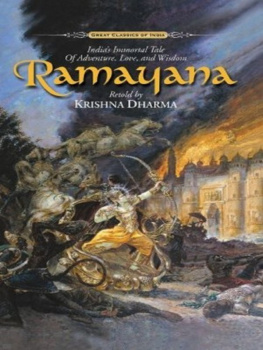
![Krishna Dharma - Mahabharata: [the greatest spiritual epic of all time]](/uploads/posts/book/213378/thumbs/krishna-dharma-mahabharata-the-greatest.jpg)

